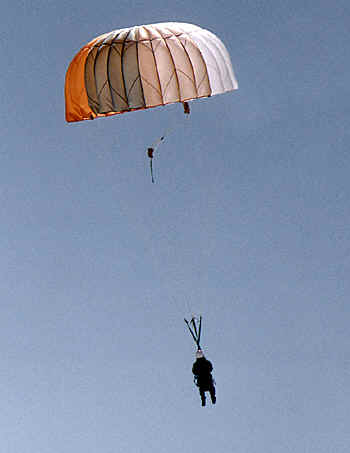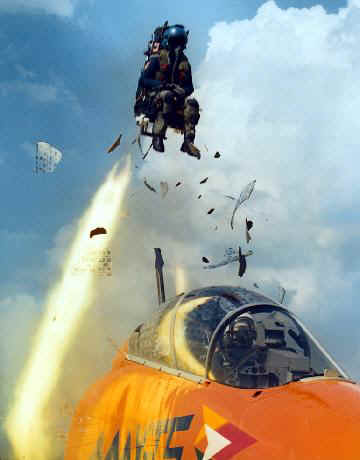Anyone who has flown an ejection seat-equipped airplane or worn a
parachute has, at one time or another, contemplated their actual use. For
military aviators whose
airplanes are owned by the government, the decision to "give it back to the
taxpayers" by ejecting or bailing out is certainly not easy, but military jet-jocks
are taught from Day One that the airplane is expendable, and they are not. Consequently,
most military pilots would have absolutely no problem pulling the handles if things got
bad, knowing full well there would be little second-guessing from their superiors,
and there would probably be few, if any, negative career repercussions.
After talking with several fellow warbird operators about their
philosophy regarding the use of the ejection seats and/or parachutes in their jets, I've found wildly different opinions. I suppose that in the end, this is an area
of aviation opinion that's
impossible to standardize and regulate, and rightly so. But allow me to share a few opinions that have
come from many years of flying with a rocket seat strapped to my backside.
First (and I'll be blunt), if you skimp on either your equipment,
training or personal preparation, you should be prepared to pay a huge price for your
frugality and laziness. There are all sorts of scenarios and situations that might result
in you having to leave your airplane, including midair collisions, structural failures,
engine failures over inhospitable terrain (or even hospitable terrain, in some airplanes),
critical system failures, in-flight fires, certain landing gear malfunctions, spatial
disorientation, physiological factors, and even poor weather. Any of these factors can
result in your demise if you don’t have a way out. It should go without saying that
your equipment must be well maintained, and you must know how to use it correctly.
The most critical factor in the operation of your egress system,
whether it’s a high-powered, automatic seat or a totally-manual bailout procedure, is
your decision to use it. No one likes to think about abandoning an airplane they might
have worked long and hard to acquire, maintain, and train in. But sometimes,
there are no
alternatives. History shows that the decision to get out is often made quickly, and as a
result of a catastrophic event. Regardless of the particular situation, you must
be extraordinarily decisive about getting out, and your decision must be based on a
pre-determined set of criteria. That criteria is determined by the capabilities
of your system, and by the personal minimums you set — the "padding" you
build for yourself, so to speak.
For example, many current Air Force and Navy fighters have two
"desired-minimum" altitudes established for ejection:
Approximately 2,000 feet AGL if the
airplane is controllable, and 10,000 feet AGL if it’s out of control. These minimums
allow enough time for the ejection system to operate and the parachute to open, and for
the pilot to be able to correct any parachute malfunctions and steer himself away from
hazards on the ground. The 2000-foot minimum assumes a wings-level attitude and a minimal
descent rate. Remember that these numbers are for a modern, rocket-equipped ejection seat,
not a manual bailout. Is a manual bailout possible below 2,000 feet AGL?
Yes, but every foot lower means a slight decrease in the survival rate.
A critical, but often overlooked, factor in a successful ejection or
bailout is your descent rate vs. your altitude. The historic rate of successful ejections
decreases dramatically if the airplane is near the ground and descending. An upward
vector, no matter how you get it, will greatly increase your chances of surviving —
even at very low altitudes. This is true for all airplanes and all egress systems.
Altitude and/or an upward vector are life. 
Other factors in a successful egress vary from aircraft to aircraft,
and space doesn't allow me to begin addressing the variations in systems and capabilities.
It’s your job, as a responsible operator, to know what your particular system can and
can’t do. Find experts and learn from them. Also, ask yourself some
tough questions. Decide exactly which situations would
cause you to leave the airplane, and which wouldn't. Be creative. What if you blew a tire
on takeoff and found yourself heading off the runway at high speed toward the trees?
What’s the slowest airspeed possible for a safe ground ejection? What if you
experienced a total loss of thrust on a half-mile final? Would you make it to the runway?
If so, could your airplane even be landed? (Some airplanes, with hydraulic
flight controls powered by engine-driven pumps, become instant falling
bricks when the pumps stop turning.) Below what altitude in the base turn are you
out of the ejection/bailout envelope? How do you jettison the canopy? How do you open your parachute manually? (Have you
sat in the cockpit and practiced reaching for your D-ring lately?)
Ask yourself some questions, research the answers, then set limits
and stick to them. As a pilot of a warbird, you must absolutely know when
it’s time to leave, and how to do it if the need arises. Right now, while you’re
on the ground, is the time to think about ejection/bailout decisions, and to develop some
personal minimums. If you're aloft and your situation deteriorates to a certain level,
you've got the rest of your life to think about what to do.